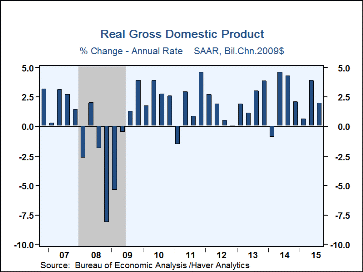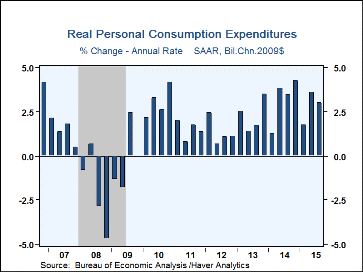 Global| Dec 22 2015
Global| Dec 22 2015U.S. GDP Growth Is Revised Down Slightly; Corporate Profits Decline
by:Tom Moeller
|in:Economy in Brief
Summary
Economic growth was revised to 2.0% (AR) during Q3'15 from 2.1% reported last month. Expectations had been for a 1.8% increase in the Action Economics Forecast Survey. The figures still show improvement from the advance reading of a [...]
Economic growth was revised to 2.0% (AR) during Q3'15 from 2.1% reported last month. Expectations had been for a 1.8% increase in the Action Economics Forecast Survey. The figures still show improvement from the advance reading of a 1.5% increase. They are reduced, however, from 3.9% growth during Q2. A slower rate of inventory decumulation reduced growth last quarter by 0.7 percentage points, revised from 0.6 points. Final demand growth was unrevised at 2.7%. Deterioration in the foreign trade deficit subtracted a greater 0.3 percentage points. Domestic final sales growth of 2.9% was unrevised. y. The GDP chain price index rose an unchanged 1.3%.
Overall corporate profits before tax, with inventory & capital consumption adjustments, fell 1.6% (-5.1% y/y). It was the third decline in the last four quarters. Earnings from abroad fell 5.7% (-10.6% y/y) and nonfinancial sector earnings eased 0.9% (-4.3% y/y). Financial sector profits nudged 0.5% higher (-2.4% y/y).
Domestic final demand growth of 2.9% was unrevised and reflected a 3.0% improvement in consumer expenditures. Durable goods spending rose 6.6% as spending on motor vehicles grew 3.0% (3.3% y/y), furniture & appliances spending gained 8.7% (6.1% y/y) and recreational goods purchases jumped 10.2% (8.4% y/y). Spending on nondurable goods grew 4.2% (3.1% y/y) as clothing purchases improved 1.3% (3.5% y/y). Gasoline and fuel oil consumption jumped 5.2% (4.7% y/y), with lower prices, and services spending improved 2.1% (2.8% y/y). Health care spending strengthened 3.6% (4.6% y/y) but recreation spending nudged just 0.1% higher (1.5% y/y). Business fixed investment improved 2.6% as equipment spending jumped 9.9% (1.8% y/y), bolstered by a 27.2% surge (8.7% y/y) in information processing equipment. Intellectual property products purchases eased a slight 0.8% (+5.4% y/y). It was the first quarterly shortfall in over two years. Structures spending fell 7.2% (-1.2% y/y) and reversed the Q2 rise. Residential investment improved 8.2% (9.4% y/y), the weakest rise in a year.
Growth in government purchases was revised up to 1.8% though defense spending fell 1.4% (-2.7% y/y). Nondefense purchases by the federal government rose 2.8% (1.4% y/y), the same as state & local buying (1.4% y/y).
The increased subtraction from GDP growth due to deterioration in net exports reflected a 0.7% advance (1.2% y/y) in exports. It was outpaced by a 2.3% gain (5.6% y/y) in imports.
The GDP price index increased an unrevised 1.3% (0.9% y/y). The personal consumption price index grew 1.3% (0.3% y/y) as a 0.3% easing in the goods price index (-2.9% y/y) was paced by a 2.9% decline in durables (-2.1% y/y). The nondurable goods price index rose 0.8% (-3.2% y/y) but services prices increased 2.0% (1.9% y/y). The business fixed investment price index rose 1.2% (0.1% y/y), the first increase since Q4'14. The residential price index gained 2.6% (1.5% y/y), also the first rise in three quarters.
The GDP figures can be found in Haver's USECON and USNA databases; USNA contains virtually all of the Bureau of Economic Analysis' detail in the national accounts, including the integrated economic accounts and the recently added GDP data for U.S. Territories. The Action Economics consensus estimates can be found in AS1REPNA.
| Chained 2009 $ (%, AR) | Q3'15 (Third Estimate) | Q3'15 (Second Estimate) | Q3'15 (Advance Estimate) | Q2'15 | Q1'15 | Q3 Y/Y | 2014 | 2013 | 2012 |
|---|---|---|---|---|---|---|---|---|---|
| Gross Domestic Product | 2.0 | 2.1 | 1.5 | 3.9 | 0.6 | 2.1 | 2.4 | 1.5 | 2.2 |
| Inventory Effect | -0.7 | -0.6 | -1.4 | 0.0 | 0.9 | 0.1 | 0.0 | 0.1 | 0.1 |
| Final Sales | 2.7 | 2.7 | 3.0 | 3.9 | -0.2 | 2.1 | 2.4 | 1.4 | 2.1 |
| Foreign Trade Effect | -0.3 | -0.2 | -0.0 | 0.2 | -1.9 | -0.7 | -0.1 | 0.2 | 0.2 |
| Domestic Final Sales | 2.9 | 2.9 | 2.9 | 3.7 | 1.7 | 2.8 | 2.8 | 1.2 | 1.9 |
| Demand Components | |||||||||
| Personal Consumption Expenditures | 3.0 | 3.0 | 3.2 | 3.6 | 1.7 | 3.2 | 2.7 | 1.7 | 1.5 |
| Business Fixed Investment | 2.6 | 2.4 | 2.1 | 4.1 | 1.6 | 2.2 | 6.2 | 3.0 | 9.0 |
| Residential Investment | 8.2 | 7.3 | 6.1 | 9.4 | 10.1 | 9.4 | 1.8 | 9.5 | 13.5 |
| Government Spending | 1.8 | 1.7 | 1.7 | 2.6 | -0.1 | 0.7 | -0.6 | -2.9 | -1.9 |
| Chain-Type Price Index | |||||||||
| GDP | 1.3 | 1.3 | 1.2 | 2.1 | 0.1 | 0.9 | 1.6 | 1.6 | 1.8 |
| Personal Consumption Expenditures | 1.3 | 1.3 | 1.2 | 2.2 | -1.9 | 0.3 | 1.4 | 1.4 | 1.8 |
| Less Food/Energy | 1.4 | 1.3 | 1.3 | 1.9 | 1.0 | 1.3 | 1.5 | 1.5 | 1.9 |
Tom Moeller
AuthorMore in Author Profile »Prior to joining Haver Analytics in 2000, Mr. Moeller worked as the Economist at Chancellor Capital Management from 1985 to 1999. There, he developed comprehensive economic forecasts and interpreted economic data for equity and fixed income portfolio managers. Also at Chancellor, Mr. Moeller worked as an equity analyst and was responsible for researching and rating companies in the economically sensitive automobile and housing industries for investment in Chancellor’s equity portfolio. Prior to joining Chancellor, Mr. Moeller was an Economist at Citibank from 1979 to 1984. He also analyzed pricing behavior in the metals industry for the Council on Wage and Price Stability in Washington, D.C. In 1999, Mr. Moeller received the award for most accurate forecast from the Forecasters' Club of New York. From 1990 to 1992 he was President of the New York Association for Business Economists. Mr. Moeller earned an M.B.A. in Finance from Fordham University, where he graduated in 1987. He holds a Bachelor of Arts in Economics from George Washington University.












